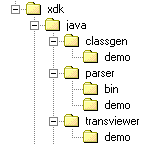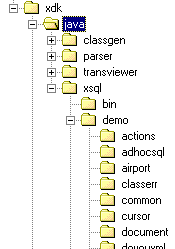XML Features of Oracle 8i and 9i (7/7) - exploring XML
XML Features of Oracle 8i and 9i
Conclusion
Relational data is by definition highly structured and is usually best searched or processed using the built in capabilities of the database. Normally there would be no particular advantage to convert db data to XML, a technology which is best for processing relatively unstructured and irregular data. However, using XML and databases together may be worth doing particularly in web applications, where the same data needs to be delivered in different formats (HTML, text, PDF) in which case XML can be a convenient intermediate format. Secondly, in B2B aplications where XML is already a communications standard.
The Oracle XML tools enable easy conversion of data between the database and XML. In practice, the most flexible tool is the Java XSQL servlet which provides full create, read, update and delete operations linked with corresponding XML input/output. The JDK included with Oracle includes a standard XML parser for further processing, for example with XSL.
Pointers and Resources
The following resources are helpful in exploring Oracle's XML capabilities:
Manuals
Documentation is available at Oracle's TechNet Web site, after registering for free.
- "Oracle 8i Application DeveloperÂ’s Guide - XML", 1264 pages, a86030.pdf
- "Oracle 8i XML Reference Guide", 824 pages, a83730.pdf
Where to find the XML tools in your Oracle installation:
Location of files and demo application
XSU tool (for different java versions):
$ORACLE_HOME/rdbms/jlib/xsu111.jar $ORACLE_HOME/rdbms/jlib/xsu12.jar
Java XDK, including demo applications:

XSQL servlet and demo applications:

About the Author
Simon Humeis a developer and trainer specialising in Web applications, databases and Linux.
Produced by Michael Claßen
URL: https://www.webreference.com/xml/column81/7.html
Created: May 10, 2003
Revised: May 10, 2003


 Find a programming school near you
Find a programming school near you